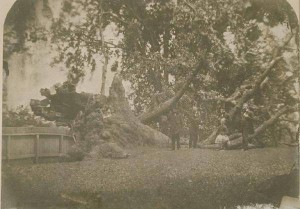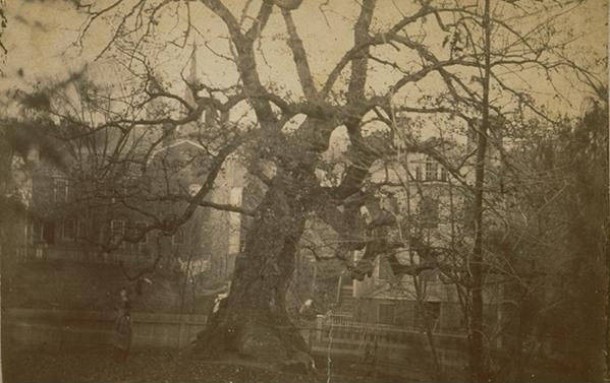On August 21, 1856, the Charter Oak, a noted landmark and symbol of Hartford and Connecticut, fell during a severe wind and rain storm. The name “Charter Oak” came from local legend and a much-told Connecticut tale in which a hollow space in the tree was used to hide the colony’s charter. The tree’s history does not begin with the hiding of the colony’s charter, however. Long before white settlers came to the colony, generations of Native Americans held their councils beneath its massive branches, and during his European voyage up the Connecticut River, Adriaen Block was so impressed with the tree that he took note of it in the journey’s logbook.
The land on which the tree stood was eventually purchased by Stephen Wyllys, one of Hartford’s first landowners. Tradition has it that while Wyllys cleared the land for his homestead and farming he was visited by a delegation of Indians who pleaded with him to not remove the great tree. Wyllys agreed and the tree stood for almost two centuries longer.

The Charter Oak, taken the morning of its fall – Connecticut Historical Society
Following the days after the storm, the people of Connecticut formally mourned the tree, and pieces of its wood were treated as treasures: three chairs were carved out of its trunk, including one that is the ceremonial seat of the president of the State Senate, a frame that now contains the colony’s charter, as well as a number of other items which can be seen at the capitol building and the Connecticut Historical Society.
In 1905, a monument was erected at the location of the fallen oak tree. It stands at the corner of Charter Oak Avenue and Charter Oak Place in Hartford’s downtown. The monument, a round column topped by a globe and supported by a base with four whales and sea shells reads, “Near this spot stood the Charter Oak, memorable in the history of the colony of Connecticut as the hiding place of the charter October 31, 1687. The tree fell August 21, 1856.”
Today, the tree remains a symbol of Connecticut and has been pictorially represented in four paintings; two of which are in the collection of the Wadsworth Atheneum Museum of Art, and two of which are in the Connecticut Historical Society’s collections. In 1935, a three-cent U.S. postage stamp was issued depicting the tree, as well as the obverse of a commemorative half-dollar issued the same year. In 1999 the Charter Oak was chosen as Connecticut’s state symbol on the state quarter.
Children, grandchildren, and great-grandchildren of the Charter Oak exist all over the state of Connecticut. These relatives can be seen in places like Bushnell Park in Hartford and Fairview Cemetery in New Britain.








